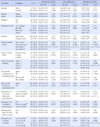This article has been corrected. See "CORRIGENDUM" in Volume 21 on page 457.
Abstract
Purpose
This was a correlational study to identify effects of perception of clinical ladder system on job satisfaction and intention to leave in perioperative nurses.
Methods
Participants were 154 of perioperative nurses from larger general hospitals in Seoul. Data were collected from April, 16 to 22, 2013 using self-report questionnaires which included items on perception of clinical ladder system, job satisfaction, and intention to leave. Data were analyzed using frequency, t-test, ANOVA, Scheffe? test, Pearson correlation coefficients, and multiple stepwise regression.
Results
The average mean score for perception of clinical ladder system was midline at 2.69 point out of 4 point. Perception of clinical ladder system correlated positively with job satisfaction (r=.38, p<.01) and negatively with intention to leave (r=-.88, p<.01). Perception of clinical ladder system was the factor which most influenced job satisfaction explaining 17.1% of the variance, also perception of clinical ladder system was the factor which most influenced intention to leave, explaining 12.7% of the variance.
Figures and Tables
Table 1
Difference of Perception of Clinical Ladder System, Job Satisfaction, Intention to Leave according to Demographic and Job-related Characteristics (N=154)

Table 2
Mean & Average Mean of Perception of Clinical Ladder System, Job Satisfaction, Intention to Leave (N=154)

Table 3
Correlation of Perception of Clinical Ladder System, Job Satisfaction, and Intention to Leave (N=154)

References
1. Korea Health Industry Development Institute, Health Industry White Paper. Health Industry Report. Seoul: Korea Health Industry Development Institute;2011. p. Report No. ISSN 1599-1423.
2. Hospital Nurses Association, Hospital nurse staffing status survey. Business Report. Seoul: Hospital Nurses Association;2013. p. 104.
3. Yoon SH. A study on new graduate nurses' clinical experience of adaptation. J Korean Acad Nurs Adm. 2002; 8(1):55–72.
4. Doo EY. Hospital organization's internal marketing impact on nurse turnover intention, perform nursing duties and productivity of nursing care [master's thesis]. Seoul: Korea University;2004.
5. Park HS. Relationship between perceived nursing care role orientation, job characteristics, and turnover among nurses [master's thesis]. Seoul: Yonsei University;2002.
6. Bae HJ. A study on verbal violence experience, job stress and turnover intention among operating room nurses [master's thesis]. Daejeon: Eulji University;2012.
7. Zimmer MJ. Rationale for a ladder for clinical advancement. J Nurs Adm. 1972; 2(6):18–24.
8. Benner P. From novice to expert: Excellence and power in clinical nursing practice. Am J Nurs. 1982; 82(3):402–407.
9. Park KO, Lee YY. Career ladder system perceived by nurses. J Korean Acad Nurs Adm. 2010; 16(3):314–325. DOI: 10.11111/jkana.2010.16.3.314.
10. Jang KS. A study on establishment of clinical development model of nurses [dissertation]. Seoul: Yonsei University;2000.
11. Murray M. Where are career ladders going in the 90's? Nurs Manage. 1993; 24(6):46–48.
12. Fusielro J, Lini L, Prohaska P, Szweda C, Carney K, Mion LC. The career advancement for registered nurses excellence program. J Nurs Adm. 2008; 38(12):526–531. DOI: 10.1097/nna.0b013e31818ebf06.
13. Hall LM, Waddell J, Donner G, Wheeler MM. Outcomes of a career planning and development program for registered nurses. Nurs Econ. 2004; 22(5):231–238.
14. Hsu N, Chen B, Lee L, Chen C, Lai C. The comparison of nursing competence pre-and postimplementing clinical ladder system. J Clin Nurs. 2005; 14:264–265. DOI: 10.1111/j.1365-2702.2004.00980.x.
15. Drenkard K, Swartwout E. Effectiveness of a clinical ladder program. J Nurs Adm. 2005; 35(11):502–506. DOI: 10.1097/00005110-200511000-00007.
16. Riley JK, Rolband DH, James D, Norton HJ. Clinical ladder: Nurses' perceptions and satisfiers. J Nurs Adm. 2009; 39(4):182–188. DOI: 10.1097/NNA.0b013e31819c9cc0.
17. Ward CW, Goodrich CA. A clinical advancement process revised: A descriptive study. Medsurg Nurs. 2007; 16(3):169–173.
18. Nelson JM, Cook PF. Evaluation of a clinical ladder program in an ambulatory care Environment. Nurs Econ. 2008; 26(6):353–360.
19. Nelson J, Sassaman B, Philips A. Career ladder program for registered nurses in ambulatory care. Nurs Econ. 2008; 26(6):393–398.
20. Yoon KS, Park SA. Development and validation of an instrument to measure the job satisfaction of perioperative nurses. J Korean Clin Nurs Res. 2008; 15(1):93–106.
21. Kim HY. Developing and verifying validity of a clinical ladder system for operating room nurses [dissertation]. Gwangju: Jeonnam University;2010.
22. Kim MS, Park SA. Comparison of nursing performance by career levels in a nurse career ladder system. J Korean Acad Soc Nurs Educ. 2012; 18(2):284–292. DOI: 10.5977/jkasne.2012.18.2.284.
23. Min AR, Kim IS. Relationship of perception of clinical ladder system with professional self-concept and empowerment based on nurses' clinical career stage. J Korean Acad Nurs Adm. 2013; 19(2):254–264. DOI: 10.11111/jkana.2013.19.2.254.
24. Hackman JR, Oldham GR. Work redesign. Reading, Mass.: Addison-Wesley;1980.
25. Shin HK. Organizational socialization of new staff nurses and its related factors [dissertation]. Seoul: Yonsei University;2004.
26. Lawler EE. Satisfaction and behavior. In : Hackman JR, Lawler EE, editors. Perspectives on behavior in organizations. New York: McGraw-Hill;1983. p. 78–97.
27. Bjork IT, Hansen BS, Samdal GB, Torstad S, Hamilton GA. Evaluation of clinical ladder participation in Norway. J Nurs Scholarsh. 2007; 39(1):88–94. DOI: 10.1111/j.1547-5069.2007.00149.x.
28. Yoon K. A study on the job satisfaction and organizational commitment among perioperative nurses. J Korean Acad Nurs Adm. 2010; 16(1):86–100. DOI: 10.11111/jkana.2010.16.1.86.
29. Kim KS, Kim IS. Job characteristics model revisited: A multiple level approach. Korean Manage Rev. 1995; 24(2):139–166.
30. Goodrich CA, Ward CW. Evaluation and revision of a clinical advancement program. Medsurg Nurs. 2004; 13(6):391–398.




 PDF
PDF ePub
ePub Citation
Citation Print
Print




 XML Download
XML Download